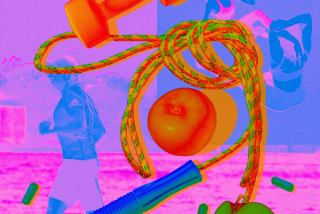Unsure where next meal comes from, low-income moms send mixed messages on food
- Share via
Latina moms who struggle to ensure their households have enough food convey messages to their infants and babies that may seem contradictory: On some days, the message may be “have more”; on others, it’s “that’s enough.” But the message that children hear may not be contradictory at all and amount to, “Pay no attention to your hunger. Eat when and as much as I say you should.”
For young Latinos, who are at very high risk of becoming obese, Mama’s confusing messages concerning food may pave the path toward obesity, write the authors of a new study. In 2008, 29.4% of Mexican American adolescent boys and 17.4% of such girls were obese (up from 14.1% and 17.4%, respectively, in 1994).
The study, published in the journal Pediatrics, looked at the feeding styles, feeding practices, perceptions and attitudes about their child’s weight among 201 low-income mothers and their babies -- 84% of the pairs being Latinos. Their aim was to see how feeding attitudes, styles and practices differed between mothers who felt they had sufficient food to feed themselves and their children and those who acknowledged they worried at least sometimes that they would not have enough.
All the moms participating in the study were recipients of assistance through the federal government’s Special Supplemental Food Program for Women Infants and Child (WIC) -- intended to ensure that pregnant women, new mothers and their young children have access to nourishing food. But WIC is a safety net with more than a few holes: 37% of those who participate in it say they are sometimes unsure they will have enough to get groceries for their family before their food runs out.
The researchers found that mothers who were termed “food insecure” had more controlling feeding styles overall: Compared with moms who were confident they had sufficient food, those who were not so confident were more likely to engage in “maternal pressuring”: For instance, even when her child “seems done,” she ackowledges she tries “to feed him or her a little bit more.” In another example of maternal pressuring, a mother reports that without her oversight, she is concerned her child might eat too little.
But the same moms were also more likely to engage in “restrictive feeding” behavior: Mama asserts that if she is not vigilant, her child may eat too much, or “much more than he or she should” without her guidance and regulation.
But a third finding seemed to hold the key to which mothers might be sending messages about food that could prime a child for later obesity. Among moms who felt secure in their family’s ability to get enough food, 22% said they were concerned that their baby could grow up to become overweight or obese. Food-insecure moms were almost twice as likely to worry their child would have a weight problem in the future -- 38.8% said they did.
As they analyzed the data, the researchers found that moms who worried about having enough food to feed their babies AND who also feared their baby would grow up overweight were most likely to send the mixed messages of “eat more” and “eat less.”
In some ways, the researchers surmised, the seeming contradiction makes perfect sense: Low-income moms may know that in the long run, when funds are scarce, high-fat, high-calories foods are often the most cheaply obtained and that eating such foods frequently will make a child fat. In the short run, however, uncertainty about the baby’s next meal drives her to urge the baby to “fill up while we have it.”
The researchers reported one more intriguing finding about a group of feeding practices widely linked to obesity: Moms who worried about their family’s food supply were no more nor less likely than moms secure in the access to food to breast-feed their babies, to feed their babies juice, or to thicken their baby’s formula with rice cereal.
Studies that track larger populations of low-income families for longer would be needed to draw closer ties to feeding styles and practices and a child’s likelihood of becoming obese. For now, we know that low-income kids are at greater risk than their more affluent peers. But many factors could be at work.
“As policy makers aim to prevent early obesity, it may be important to both decrease the overall rates of food insecurity and reduce controlling feeding styles in families who remain food insecure,” the authors wrote.







